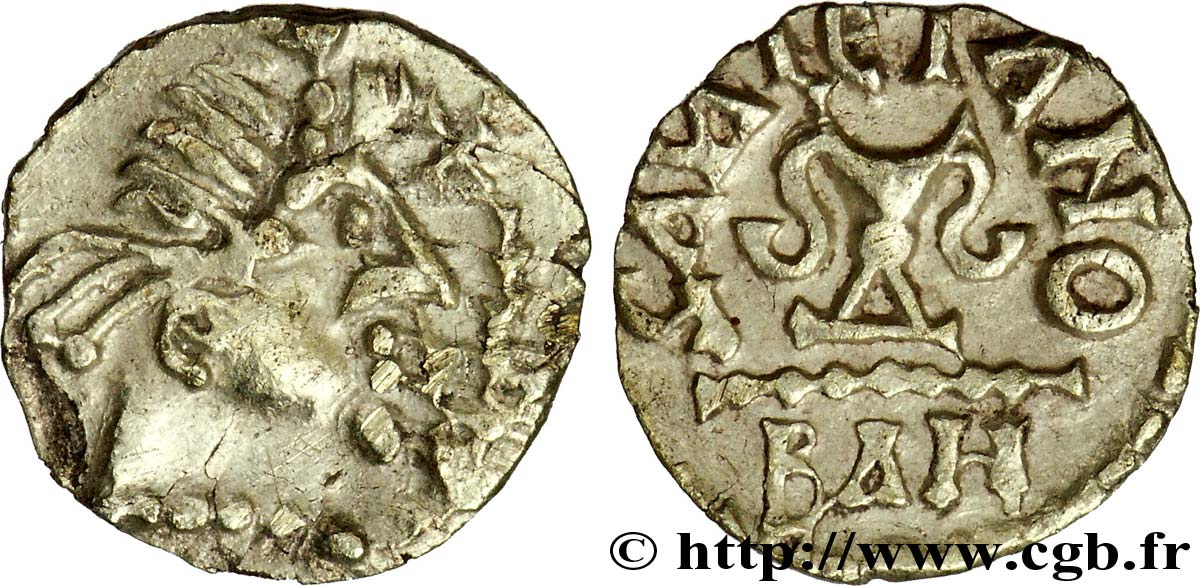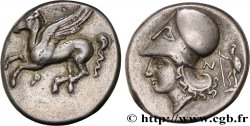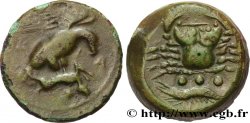v31_0892 - MEROVINGIAN COINAGE - BANASSAC (BANNACIACO) - Lozere Triens, SIGEBERT monétaire
MONNAIES 31 (2007)
Starting price : 2 000.00 €
Estimate : 3 200.00 €
Realised price : 2 675.00 €
Number of bids : 2
Maximum bid : 3 140.00 €
Starting price : 2 000.00 €
Estimate : 3 200.00 €
Realised price : 2 675.00 €
Number of bids : 2
Maximum bid : 3 140.00 €
Type : Triens, SIGEBERT monétaire
Date: (VIIe siècle)
Mint name / Town : BANASSAC
Metal : gold
Diameter : 12,5 mm
Orientation dies : 3 h.
Weight : 1,15 g.
Rarity : R3
Coments on the condition:
Beau triens complet, avec les légendes bien lisibles et une frappe vigoureuse au revers, mais un peu faible au droit avec le métal légèrement écroui devant le visage et un infime manque de métal en bord de flan derrière la nuque
Catalogue references :
Obverse
Obverse legend : ANÉPIGRAPHE.
Obverse description : Tête barbare diadémée, à droite ; diadème perlée ; calotte et bouton occipital ; devant le profil, rameaux avec une croisette devant le front.
Reverse
Reverse legend : GAVALETANO // BAH.
Reverse description : Calice à deux anses, posé sur une ligne d’exergue perlée.
Commentary
Les triens de ce type sont attribués au monétaire SIGEBERT et sont relativement abondants ce qui a permis d’en réaliser une étude précise, avec des différenciations parfois subjectives ! Sur cet exemplaire, appartenant vraisemblablement à la série D, "Avec palme à cinq branches et E lunaire", il est difficile de déterminer avec certitude le nombre de branches de la palme placée devant le visage. Cette légende GAVALETANO sans la terminaison FIT ne se retrouve que sur les triens B. 741-743. L'exergue est cependant mal lu, car e bord de flan ; il s'agit nettement des lettres BAH sur cet exemplaire !.
Triens of this type are attributed to the mint SIGEBERT and are relatively abundant, which has allowed for a precise study, with sometimes subjective differentiations! On this example, probably belonging to series D, \\\"With five-branched palm and lunar E\\\", it is difficult to determine with certainty the number of branches of the palm placed in front of the face. This legend GAVALETANO without the ending FIT is only found on triens B. 741-743. The exergue is however misread, because the edge of the flan; it is clearly the letters BAH on this example!
Triens of this type are attributed to the mint SIGEBERT and are relatively abundant, which has allowed for a precise study, with sometimes subjective differentiations! On this example, probably belonging to series D, \\\"With five-branched palm and lunar E\\\", it is difficult to determine with certainty the number of branches of the palm placed in front of the face. This legend GAVALETANO without the ending FIT is only found on triens B. 741-743. The exergue is however misread, because the edge of the flan; it is clearly the letters BAH on this example!








 Report a mistake
Report a mistake Print the page
Print the page Share my selection
Share my selection Ask a question
Ask a question Consign / sell
Consign / sell
 Full data
Full data












